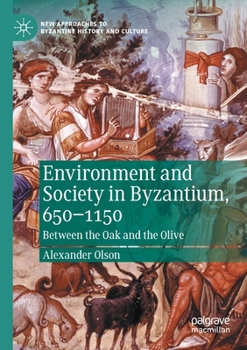Environment and Society in Byzantium, 650-1150: Between the Oak and the Olive
Select Format
Select Condition 
Book Overview
1. Introduction
2. Middle Byzantium's Environmental and Economic Antecedents2.1 Taxes and Rents, Olives and Vines, Slaves and Cattle2.2 A Transformed Economy, Culture, and Environment2.3 An Elite-less Landscape?2.4 A New Equilibrium?
3. An Evergreen Empire3.1 Woodland Species Around the Aegean3.2 The Expansion of Woodland in the Aegean Littoral3.3 Contexts for Woodland Species' Success3.4 Using Woodland
4. The Decline of the Olive in Middle Byzantium4.1 What the Olive Tree Does and How People Work with it4.2 The Olive in the Ancient and Modern Contexts4.3 The Olive in Retreat4.4 Where did the Olives go?4.5 New Uses for an Old Object
5. Re-arranging Woods and Scrub5.1 Complicating the Landscape 5.2 Contexts for Altering the Landscape5.3 Deciduous Oak's Fortunes5.4 Chestnut's Fortunes5.5 Room to Maneuver
6. The Return of the Olive6.1 Where and When the Olive Returns 6.2 Monastic Assistance6.3 From Peasants to Merchants6.4 Olives from the Scrub
7. The Devil Chops Wood7.1 Social Causes and Outcomes of a Contested Countryside7.2 Hagiography and Conflict in the Landscape7.3 Hagiographical Strategies for a Contested Landscape
8. Conclusion
2. Middle Byzantium's Environmental and Economic Antecedents2.1 Taxes and Rents, Olives and Vines, Slaves and Cattle2.2 A Transformed Economy, Culture, and Environment2.3 An Elite-less Landscape?2.4 A New Equilibrium?
3. An Evergreen Empire3.1 Woodland Species Around the Aegean3.2 The Expansion of Woodland in the Aegean Littoral3.3 Contexts for Woodland Species' Success3.4 Using Woodland
4. The Decline of the Olive in Middle Byzantium4.1 What the Olive Tree Does and How People Work with it4.2 The Olive in the Ancient and Modern Contexts4.3 The Olive in Retreat4.4 Where did the Olives go?4.5 New Uses for an Old Object
5. Re-arranging Woods and Scrub5.1 Complicating the Landscape 5.2 Contexts for Altering the Landscape5.3 Deciduous Oak's Fortunes5.4 Chestnut's Fortunes5.5 Room to Maneuver
6. The Return of the Olive6.1 Where and When the Olive Returns 6.2 Monastic Assistance6.3 From Peasants to Merchants6.4 Olives from the Scrub
7. The Devil Chops Wood7.1 Social Causes and Outcomes of a Contested Countryside7.2 Hagiography and Conflict in the Landscape7.3 Hagiographical Strategies for a Contested Landscape
8. Conclusion
Format:Paperback
Language:English
ISBN:3030599388
ISBN13:9783030599386
Release Date:November 2021
Publisher:Palgrave MacMillan
Length:258 Pages
Weight:0.79 lbs.
Dimensions:0.6" x 5.8" x 8.3"
Customer Reviews
0 rating





